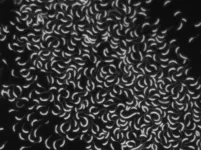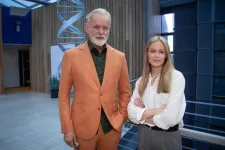(Press-News.org) The National Institute of General Medical Sciences, a branch of the National Institutes of Health (NIH), has awarded Yubing Sun, associate professor of mechanical and industrial engineering at the University of Massachusetts Amherst, a $1.9 million Maximizing Investigators’ Research Award to support the exploration of the fundamental principles behind the process that close gaps caused by injury or growth between cells. This research has the potential to push forward advances in our understanding of wound healing, cellular regeneration therapies and embryonic development.
The gaps under investigation are 0.5-5 millimeters in size, which is more physiologically relevant and comparatively large in this field. “Usually when people study those gap closure processes they’ll leave a super small gap—just a few cells in size,” says Sun. “This is larger than that—not just a few cells, but thousands or more.”
“Our biggest goal here is to have a really a good theoretical understanding of: what are the individual contributions from individual factors to this process?” he says. “When there are multiple factors involved at once, which one regulates the others?”
As an example of a gap-closure process, he points to neural tube closure during embryonic development. “It’s a well-studied process in animal models, but as an engineer, we want to introduce a more controlled environment to study how individual factors regulate this process,” he says. Normally, in animal studies, the researcher would manipulate different genes to see how this impacts development. “But everything’s changing simultaneously,” he explains. “It’s really hard to control individual factors.”
Instead, Sun and his team plan to create controlled mechanical and biochemical environments so that they can investigate one factor at a time. These factors include things like forces, gap geometry and matrix and tissue stiffness.
While the research itself is focused on understanding the fundamental processes of gap closure, Sun points to several domains where this research could support future advancement.
One future application is wound healing. Sun says that a device already exists that uses a vacuum cup to stretch the skin to accelerate the closure process—but they don’t fully understand how it works. “Right now, many parameters are empirically determined, but if you understand the process, you can design based on the principle and things become more efficient,” he says.
Another direction this research can inform is in cellular regeneration. Sun points out that newborn mice and zebrafish have hearts that can regenerate after an injury. “Imagine closing that gap or wound, and the cells on the surface of a heart can differentiate into those muscle cells in the heart,” he says. “But humans don’t have that capability.” A deep understanding of the gap-closure process could inspire future therapeutics to regenerate heart cells.
Sun points to mechanomedicine, drugs able to mimic the mechanical cues that he aims to recreate in his lab, as a possible output informed by his current, fundamental research. “You’re not directly applying mechanical cues, but you use a drug to mimic that effect,” he says.
END
Mind the Gap: NIH awards UMass researcher $1.9 million to study closing cellular gaps
Understanding this fundamental process could have implications in the realms of wound healing, cellular regeneration therapies and embryonic development
2024-08-15
ELSE PRESS RELEASES FROM THIS DATE:
Surprise Finding in study of environmental bacteria could advance search for better antibiotics
2024-08-15
**EMBARGOED UNTIL THURSDAY, AUG. 15, AT 9 A.M. ET**
In what they labeled a “surprising” finding, Johns Hopkins Medicine researchers studying bacteria from freshwater lakes and soil say they have determined a protein’s essential role in maintaining the germ’s shape. Because the integrity of a bacterial cell’s “envelope” or enclosure is key to its survival, the finding could advance the search for new and better antibiotics.
The research, described August 15 in the journal mBio, suggests that loss of a protein ...
A genetic analysis of lyme disease could improve diagnosis and treatment
2024-08-15
A genetic analysis of Lyme disease bacteria may pave the way for improved diagnosis, treatment and prevention of the tick-borne ailment.
By mapping the complete genetic makeup of 47 strains of Lyme disease-causing bacteria from around the world, the international team has created a powerful resource for identifying the specific bacterial strains that infect patients. Researchers said this could enable more accurate diagnostic tests and treatments tailored to the exact type or types of bacteria causing each patient’s illness.
"This comprehensive, high-quality sequencing investigation of Lyme disease and related bacteria provides the foundation to propel the field forward,” ...
Scientists map DNA of Lyme disease bacteria
2024-08-15
A team led by CUNY Graduate Center biologists has produced a genetic analysis of Lyme disease bacteria that may pave the way for improved diagnosis, treatment, and prevention of the tick-borne ailment.
Weigang Qiu, a professor of Biology at the CUNY Graduate Center and Hunter College, and an international team including lead author Saymon Akther, a former CUNY Graduate Center Biology Ph.D. student, mapped the complete genetic makeup of 47 strains of Lyme disease-related bacteria from around the world, creating a powerful tool for identifying the bacterial strains that ...
Researchers awarded $2.8M federal grant to study potential treatment of Sudden Infant Death Syndrome
2024-08-15
CLEVELAND—More than 3,400 Sudden Unexpected Infant Deaths are reported annually in the United States, making it the country’s biggest cause of death of infants from 1 month to 1 year old, according to the Centers for Disease Control and Prevention (CDC).
Most of these deaths are classified as Sudden Infant Death Syndrome (SIDS), a disorder with numerous, unexplained causes that have plagued researchers for decades.
Now, with a new five-year, $2.8 million grant from the National Institutes of Health, researchers from Case Western Reserve University and University Hospitals Rainbow Babies ...
Blood pressure levels impacted by chronic occupational noise exposure
2024-08-15
Noise exposure is a known occupational hazard in some jobs, particularly for hearing loss, physical and psychological stress, and reduced concentration. A new study presented at the ACC Asia 2024 conference found in adult power loom weavers, chronic noise exposure not only increased their blood pressure overall, but also each year of exposure increased their odds of having high blood pressure by 10%.
“While the mechanism is still not well-explored, it is thought that the stress response by the body to chronic sound exposure causes hormonal imbalances that gradually leads to a permanent elevation of blood pressure,” said Golam Dastageer Prince, MBBS, MPH, medical officer ...
New study finds chronic high caffeine consumption may heighten risk for cardiovascular disease
2024-08-15
From coffee to tea, caffeinated beverages are an integral part of morning routines across the globe, but these popular drinks can be harmful when enjoyed in excess. According to a new study being presented at ACC Asia 2024 in Delhi, India, drinking over 400 mg of caffeine per day on most days of the week could increase the susceptibility of otherwise healthy individuals to cardiovascular disease.
“Regular caffeine consumption could disturb the parasympathetic system, leading to elevated blood pressure ...
$1.2 million in federal funding to study women Veterans experiencing homelessness
2024-08-15
A first-of-its-kind study led by Lawson Health Research Institute is receiving $1.2 million in funding from the federal government, delivered through the Veteran Homelessness Program, to better understand homelessness amongst women in Canada who are military Veterans.
“This is an important and yet often invisible problem,” says Dr. Cheryl Forchuk, Lawson Assistant Scientific Director based at St. Joseph’s Health Care London’s Parkwood Institute and the study lead. “This is the first Canadian study to focus exclusively on women Veterans’ experience of homelessness. Gender matters, especially when we’re talking ...
Robot planning tool accounts for human carelessness
2024-08-15
PULLMAN, Wash. -- A new algorithm may make robots safer by making them more aware of human inattentiveness.
In computerized simulations of packaging and assembly lines where humans and robots work together, the algorithm developed to account for human carelessness improved safety by about a maximum of 80% and efficiency by about a maximum of 38% compared to existing methods.
The work is reported in IEEE Transactions on Systems Man and Cybernetics Systems.
“There are a large number of accidents that are happening every day due to carelessness – most of them, unfortunately, from human errors,” said lead ...
deCODE genetics: Rare sequence variants, that associate with a high risk of Parkinson‘s Disease
2024-08-15
Scientists at deCODE genetics, a subsidiary of AMGEN, have discovered rare sequence variants, predicted to cause a loss of function of ITSN1, that are associated with a high risk of Parkinson‘s Disease. The findings also support less studied pathways involved in the pathogenesis of the disease.
The study, published today in npj Parkinson‘s Disease, used whole-genome sequence data from Iceland (deCODE genetics), the UK (UK Biobank), and the US (Accelerating Medicines Partnership Parkinson‘s ...
Cleaning up the aging brain: Scientists restore brain's trash disposal system
2024-08-15
Alzheimer’s, Parkinson’s, and other neurological disorders can be seen as “dirty brain” diseases, where the brain struggles to clear out harmful waste. Aging is a key risk factor because, as we grow older, our brain's ability to remove toxic buildup slows down. However, new research in mice demonstrates that it’s possible to reverse age-related effects and restore the brain’s waste-clearing process.
“This research shows that restoring cervical lymph vessel function can substantially rescue the slower removal of waste from the brain associated with age,” said Douglas Kelley, PhD, a professor of Mechanical ...
LAST 30 PRESS RELEASES:
Human activities drive global dryland greening
PeroCycle announces new appointments as it builds a world-class board for meaningful climate impact
Magnetic avalanches power solar flares
LeapSpace goes live: the Research-Grade AI-Assisted Workspace built on trusted science
DNA tests reveal mysterious beluga family trees
Strategic sex: Alaska’s beluga whales swap mates for long-term survival
How early cell membranes may have shaped the origins of life
Cannabis legalization is driving increases in marijuana use among U.S. adults with historically lower consumption rates
Multifunctional dipoles enabling enhanced ionic and electronic transport for high‑energy batteries
Triboelectric nanogenerators for future space missions
Advancing energy development with MBene: Chemical mechanism, AI, and applications in energy storage and harvesting
Heteroatom‑coordinated Fe–N4 catalysts for enhanced oxygen reduction in alkaline seawater zinc‑air batteries
Meta-device for precision lateral displacement sensing
Plasma-guided mitotane for the treatment of adrenocortical carcinoma: adjuvant care to advanced disease
Theoretical study of laser-enhanced nuclear fusion reactions
Social environment impacts sleep quality
Optimized kinetic pathways of active hydrogen generation at Cu2O/Cu heterojunction interfaces to enhance nitrate electroreduction to ammonia
New design playbook could unlock next generation high energy lithium ion batteries
Drones reveal how feral horse units keep boundaries
New AI tool removes bottleneck in animal movement analysis
Bubble netting knowledge spread by immigrant humpback whales
Discovery of bats remarkable navigation strategy revealed in new study
Urban tributaries identified as major sources of plastic chemical pollution in the Yangtze River
UK glaucoma cases higher than expected and projected to reach 1.6 million+ by 2060
Type 2 diabetes prevention could more than halve carbon footprint linked to disease complications
Over 1 million estimated to have glaucoma in UK
Early treatment can delay rheumatoid arthritis for years
National childhood type 1 diabetes screening is effective and could prevent thousands of emergency diagnoses, UK study shows
Mix of different types of physical activity may be best for longer life
Continuous care from community-based midwives reduces risk of preterm birth by 45%
[Press-News.org] Mind the Gap: NIH awards UMass researcher $1.9 million to study closing cellular gapsUnderstanding this fundamental process could have implications in the realms of wound healing, cellular regeneration therapies and embryonic development



